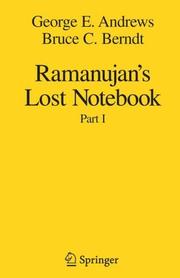| Listing 1 - 2 of 2 |
Sort by
|
Book
ISBN: 1280803495 9786610803491 0387271309 Year: 2005 Publisher: New York, NY : Springer New York : Imprint: Springer,
Abstract | Keywords | Export | Availability | Bookmark
 Loading...
Loading...Choose an application
- Reference Manager
- EndNote
- RefWorks (Direct export to RefWorks)
"... The exposition is not only clear, it is friendly, philosophical, and considerate even to the most naive or inexperienced reader. And it proves that the philosophical orientation of an author really can make a big difference. The mathematical content is intensely classical. ... Edwards makes it warmly accessible to any interested reader. And he is breaking fresh ground, in his rigorously constructive or constructivist presentation. So the book will interest anyone trying to learn these major, central topics in classical algebra and algebraic number theory. Also, anyone interested in constructivism, for or against. And even anyone who can be intrigued and drawn in by a masterly exposition of beautiful mathematics." Reuben Hersh This book aims to promote constructive mathematics, not by defining it or formalizing it, but by practicing it, by basing all definitions and proofs on finite algorithms. The topics covered derive from classic works of nineteenth century mathematics---among them Galois' theory of algebraic equations, Gauss's theory of binary quadratic forms and Abel's theorem about integrals of rational differentials on algebraic curves. It is not surprising that the first two topics can be treated constructively---although the constructive treatments shed a surprising amount of light on them---but the last topic, involving integrals and differentials as it does, might seem to call for infinite processes. In this case too, however, finite algorithms suffice to define the genus of an algebraic curve, to prove that birationally equivalent curves have the same genus, and to prove the Riemann-Roch theorem. The main algorithm in this case is Newton's polygon, which is given a full treatment. Other topics covered include the fundamental theorem of algebra, the factorization of polynomials over an algebraic number field, and the spectral theorem for symmetric matrices. Harold M. Edwards is Emeritus Professor of Mathematics at New York University. His previous books are Advanced Calculus (1969, 1980, 1993), Riemann's Zeta Function (1974, 2001), Fermat's Last Theorem (1977), Galois Theory (1984), Divisor Theory (1990) and Linear Algebra (1995). Readers of his Advanced Calculus will know that his preference for constructive mathematics is not new.
Constructive mathematics. --- Mathematics. --- Algebra. --- Algebraic geometry. --- Sequences (Mathematics). --- Mathematical logic. --- Number theory. --- Mathematics, general. --- Algebraic Geometry. --- Sequences, Series, Summability. --- Mathematical Logic and Foundations. --- Number Theory. --- Number study --- Numbers, Theory of --- Algebra --- Algebra of logic --- Logic, Universal --- Mathematical logic --- Symbolic and mathematical logic --- Symbolic logic --- Mathematics --- Algebra, Abstract --- Metamathematics --- Set theory --- Syllogism --- Mathematical sequences --- Numerical sequences --- Algebraic geometry --- Geometry --- Mathematical analysis --- Math --- Science --- Mathematics, Constructive --- Logic, Symbolic and mathematical --- Geometry, algebraic. --- Logic, Symbolic and mathematical.

ISBN: 1280308346 9786610308347 038728124X 038725529X 1441920625 Year: 2005 Publisher: New York, NY : Springer New York : Imprint: Springer,
Abstract | Keywords | Export | Availability | Bookmark
 Loading...
Loading...Choose an application
- Reference Manager
- EndNote
- RefWorks (Direct export to RefWorks)
This volume is the first of approximately four volumes devoted to providing statements, proofs, and discussions of all the claims made by Srinivasa Ramanujan in his lost notebook and all his other manuscripts and letters published with the lost notebook. In addition to the lost notebook, this publication contains copies of unpublished manuscripts in the Oxford library, in particular, his famous unpublished manuscript on the partition and tau-functions; fragments of both published and unpublished papers; miscellaneous sheets; and Ramanujan's letters to G. H. Hardy, written from nursing homes during Ramanujan's final two years in England. This volume contains accounts of 442 entries (counting multiplicities) made by Ramanujan in the aforementioned publication. The present authors have organized these claims into eighteen chapters, containing anywhere from two entries in Chapter 13 to sixty-one entries in Chapter 17. Most of the results contained in Ramanujan's Lost Notebook fall under the purview of q-series. These include mock theta functions, theta functions, partial theta function expansions, false theta functions, identities connected with the Rogers-Fine identity, several results in the theory of partitions, Eisenstein series, modular equations, the Rogers-Ramanujan continued fraction, other q-continued fractions, asymptotic expansions of q-series and q-continued fractions, integrals of theta functions, integrals of q-products, and incomplete elliptic integrals. Other continued fractions, other integrals, infinite series identities, Dirichlet series, approximations, arithmetic functions, numerical calculations, diophantine equations, and elementary mathematics are some of the further topics examined by Ramanujan in his lost notebook.
q-series. --- Mathematics. --- Ramanujan Aiyangar, Srinivasa, --- Math --- Science --- Series --- Ṣrīnivāsa-Rāmānuja Aiyaṅgār, --- Ramanujan, Srinivasa, --- Aiyangar, Srinivasa Ramanujan, --- Iyengar, Srinivasa Iyengar Ramanuja, --- Ramanuja Iyengar, Srinivasa Iyengar, --- Ramanudzhan Aĭengar, --- Ramanujan, S. --- Ramanujam, S. --- Geometry, algebraic. --- Sequences (Mathematics). --- Functions, special. --- Algebraic Geometry. --- Sequences, Series, Summability. --- Special Functions. --- Special functions --- Mathematical analysis --- Mathematical sequences --- Numerical sequences --- Algebra --- Mathematics --- Algebraic geometry --- Geometry --- Algebraic geometry. --- Special functions.
| Listing 1 - 2 of 2 |
Sort by
|

 Search
Search Feedback
Feedback About
About Help
Help News
News